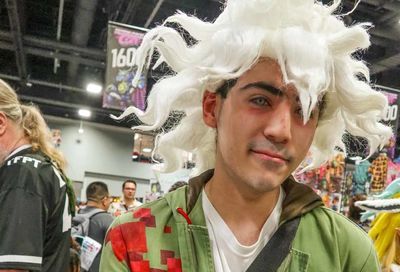Review: Crash Bandicoot N. Sane Trilogy
Crash Bandicoot N. Sane Trilogy is a flawed yet faithful remastering of a gaming icon

Nostalgia can be a powerful thing. Memories can alter with time, particularly when viewed through the rose-tinted spectacles of childhood. Gamers are especially susceptible to nostalgia: We all remember our first games console, our first wow moment, our favorite characters.
But, often, our memories are wrong. With years of hindsight, experience, and vast improvements in the technical quality of games, revisiting those same beloved games can prove an immensely frustrating, disappointing, or simply uninteresting experience. Graphics that seemed crystal clear are now hideously muddy. Gameplay that gripped and enthralled is now slow and clunky. Sublime moments now seem contrived, given the tendency today towards cinematic direction and accomplished voice acting.
I say all this, because anyone who owned the original PlayStation will likely have encountered Crash Bandicoot. Naughty Dog’s orange icon spun and jumped his way through three multi-million-selling platform games and a Mario Kart-style racer on Sony’s landmark console. Those memories of Crash’s adventures to thwart the maniacal Dr. Neo Cortex and his plans for world domination are shared by thousands of gamers the world over. The difficulty of the original, the expanded worlds of the second game, the gameplay variety of the third title. The colorful graphics, the zany soundtrack, the altered perspectives, and multitude of characters. Crash Bandicoot became an icon of the era for all the right reasons.
It’s why revisiting those memories might be, for some, painful. Slide a disc into an older PlayStation and that disconnect between memory and reality will be readily apparent. Crash’s world is a low-resolution, less colorful, and oddly compact place. But the fondness remains, and that’s why Activision tasked Vicarious Visions — no strangers to the franchise, having created Crash titles for the Gameboy Advance plus 2003’s Crash Nitro Kart — with dragging Crash Bandicoot and his original three games into the modern era.
And what a job they’ve done. Crash Bandicoot N. Sane Trilogy (FOUR STARS) is a glowing testament to the value that remastering older games can offer. Sure, it’s an easy cash-grab slathered in nostalgia, but it’s also a beautiful, engrossing, value-packed effort that reminds why so many fell in love with Crash in the first place — and, that regardless of how far gaming technology has come, there are still some titles that are outstanding, regardless of era.
For starters, it is never anything less than utterly gorgeous. Vicarious mapped out every level from Crash Bandicoot, Crash Bandicoot 2: Cortex Strikes Back, and Crash Bandicoot 3: Warped, and then rebuilt them from the ground up to work on the PlayStation 4. Where Crash was previously relegated to the pre-HD resolution of the PlayStation, he’ll now run in stunning 4K on the PS4 Pro. The texture work is outstanding, with a beautiful sense of depth, impressive lighting, and smooth animations. From the rich foliage on N. Sanity Beach to the beautiful water physics in Hang Eight, to the neon future cityscapes of Gone Tomorrow, the N. Sane Trilogy never fails to wow. Watch the intense burst of fire from TNT crates as it illuminates its surroundings, before petering out into a whiff of smoke, and you’ll see just how vastly improved this remaster is.

The accompanying explosion also showcases the reworked sound. From the thumping soundtrack, with its drums, guitars, and whimsical tones, to the creature noises, to the voice acting, to Crash’s little yelps and shouts as he works through levels, there’s a richness and faithfulness that only enhances the nostalgia.
However, once you get over the technical wonder, play through the first few levels of the first Crash Bandicoot, and hit some of the more challenging areas, you’ll encounter the N. Sane Trilogy‘s inescapable — and, to some extent, potentially game-breaking — flaw. Naughty Dog, the original developers, tweaked the way Crash handled between titles, as feedback rolled in from gamers and critics. Vicarious was faced with a dilemma: keep the three different control schemes, or pick one and apply it to every title. For the sake of consistency — the N. Sane Trilogy lets you jump between all three games as you please — they opted for the latter option. In some cases, this makes sense. Take the remaster of the Uncharted series, another Naughty Dog creation. The third game’s control scheme was applied to the first two titles, something that made sense given all three shared similar run and gun gameplay. The problem with applying the same controls to all three Crash games is that Naughty Dog tweaked a number of things between games, including level design and gameplay style, with less focus on making precise jumps and greater variety of gameplay types.
It’s Crash Bandicoot, the original game, that presents the biggest problem here. Notoriously difficult when it launched in 1996, levels such as High Road and Slippery Climb were notorious for their punishing demands on gamers. Twenty years later, that remains true, but Vicarious has introduced a number of additional challenges. First is that enemies, platforms and ledges now have much more precise hitboxes — essentially, the area that the game detects as applying to that object. Landing on top of an enemy was easier in the original game, because the PlayStation applied a less defined area to them, giving Crash a large canvas to land on. In this remaster, the hitbox is almost pixel perfect to the creature’s shape, demanding greater accuracy in attacks. Leaping onto objects is similarly more challenging: where Crash could previously hit the edge of something and survive, he’ll now either miss or just hit and then slip off.
Add to that a control scheme that emphasizes momentum in a way the original game never did. One Reddit user took it upon themselves to directly compare both the original game and the N. Sane Trilogy and found that momentum, or the lack thereof in the original, was the key difference. Crash could leap forward from a standstill in 1996, but now he requires a run up. It makes levels such as Road to Nowhere, which takes place on tiny planks suspended high over a ravine, near impossible for those that lack fine motor controls. My time with the first game was an obscenity laden, rage-inducing nightmare of frustration and restarting.
Thankfully, Cortex and Warped are much easier. Indeed, they showcase the adjustments Naughty Dog made to the difficulty between titles. Levels expanded, Crash gained more moves, boss battles became a little less rigid. You can easily build up lives, whereas the first game will have you expending them at an almost comical pace. And, that’s also one of the N. Sane Trilogy‘s greatest strengths: get stuck on the first game and you can jump into the second and third. The plot is wafer thin, so you won’t miss anything there, and can instead revel in some of gaming’s finest platforming action. What’s more, with a bit more practice in the later games, you might find the first game that little less challenging.
The argument for remastering older titles is still one fraught with complaints about exploiting nostalgia for money and pulling focus from creating new and better games. And that’s true to some extent. For anyone who played the original Crash games, or downloaded the digital versions on PS3/PSP/PS Vita, there’s perhaps less reason to buy the N. Sane Trilogy. What’s more, while Activision isn’t charging full price, at $40, it’s not cheap. That’s a lot of money for 20-year-old games.
But the value shines through, not least for those who have never experienced Crash’s worlds and even for those who maybe haven’t played the games since their original outing. The sheer joy of seeing Crash rendered with the beauty and color that he exists in my memory — if not in the reality of the PlayStation games as played today — is worth the price of entry alone. And punishing gameplay aside, there’s a lot of replayability, including time trials, collectibles and trophies. The N.Sane Trilogy isn’t perfect. Sacrifices had to be made to drag Crash into the PS4 era. But as a nostalgic trip down memory lane, it’s phenomenal. Now, when can we expect the Crash Team Racing remaster?
Crash Bandicoot N. Sane Trilogy is $39.99 and available for download on PlayStation 4 or via disk at Amazon.com and other retailers.
Support Metro Weekly’s Journalism
These are challenging times for news organizations. And yet it’s crucial we stay active and provide vital resources and information to both our local readers and the world. So won’t you please take a moment and consider supporting Metro Weekly with a membership? For as little as $5 a month, you can help ensure Metro Weekly magazine and MetroWeekly.com remain free, viable resources as we provide the best, most diverse, culturally-resonant LGBTQ coverage in both the D.C. region and around the world. Memberships come with exclusive perks and discounts, your own personal digital delivery of each week’s magazine (and an archive), access to our Member's Lounge when it launches this fall, and exclusive members-only items like Metro Weekly Membership Mugs and Tote Bags! Check out all our membership levels here and please join us today!























You must be logged in to post a comment.